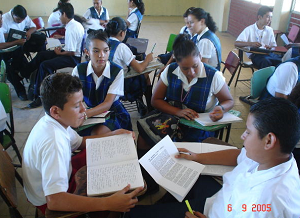Strategies for ELL Students: Instructional Conversation

 Over the years, a number of strategies for ELL students have been
Over the years, a number of strategies for ELL students have been
developed. ELL or English Language Learners benefit from interactive
learning strategies. “Instructional Conversation” (IC) is one
such strategy.
IC is the hardest of The Center for Research on Education, Diversity & Excellence (CREDE) standards to implement as it involves releasing control over the talk in the classroom, or in other words, letting the students talk to each other about educational content.
ELLs need opportunities to practice their speaking skills in authentic, interactive situations. They also require guidance. IC combines all of these elements with the demands of a rigorous curriculum by challenging students to think at complex levels. This is one the strategies for ELL students.
Using IC, however, doesn’t mean turning the students loose to talk about whatever they want. The teacher must be part of the conversation, setting a clear goal and guiding the dialogue along. The teacher will also need to give explicit directions for participation as well.
It’s important that the teacher does not set herself up as the center of the dialogue. In fact, she can ask, “Is someone willing to start the conversation?” That way, she is not automatically viewed as the “leader.”
Facilitation
As the conversation progresses, the teacher should repeat key ideas for emphasis, paraphrase when necessary, keep clear communication in mind, and allow for natural pauses in the conversation. Such implementation assists students in thinking.
If an ELL is struggling with language, the teacher should simply nod encouragingly and try at first not to put words in the student’s mouth. If, after a time, she thinks she knows what the student is trying to say, she can suggest some language, then ask, “Is that what you wanted to say?”
Authenticity
Rather than sounding like students are reading from a script or saying what they think the teacher wants to hear, IC should resemble an authentic conversation. The topic should be something genuinely interesting, such as a problem-solving task, that requires the students to use higher-order thinking skills.
Using real-world conversations as a model, the teacher should not hesitate to respond with emotion. She should also resist making “teacherish” evaluative comments (“Very good!” or “That’s correct”), and rather use neutral responses such as “Hmmm” and “I see.”
Have you facilitated an Instructional Conversation before? Share your experiences.
From Professional Learning Board’s online continuing education course for teachers: Teaching English Language Learners




Stephanie Harvey, one of my literacy gurus, focuses on students “Turning and Talking” to make connections as they read. Students learn to listen to each other respectfully as they share their personal connections with the book, talk about aspects of culture of the main character is experiencing in his/her new culture. As young children learn to listen and talk to one another, they learn new perspectives, new ways of thinking. Children begin to know how to show respect for one another, which transfers to collaborative conversations in larger groups. ELL students feel comfortable sharing with one another without feeling put on the spot. Many new students from other countries come to the U.S. without a knowledge of English. Talking 1-1 with students is the beginning of learning English, having authentic conversations, and building a respectful and caring classroom community.